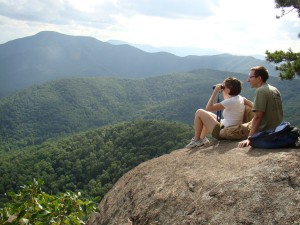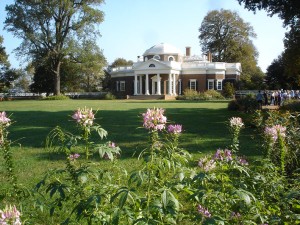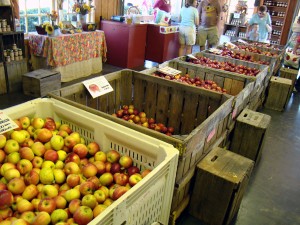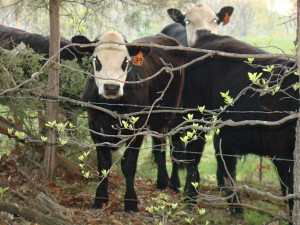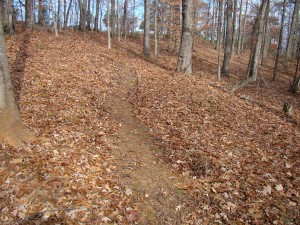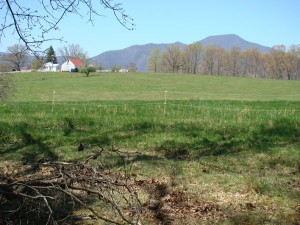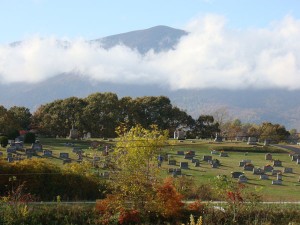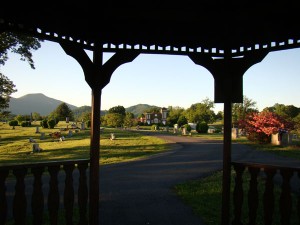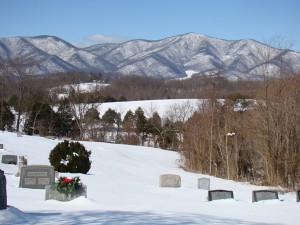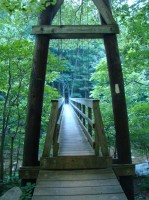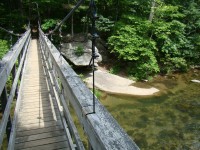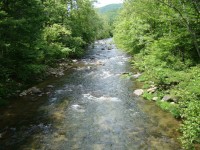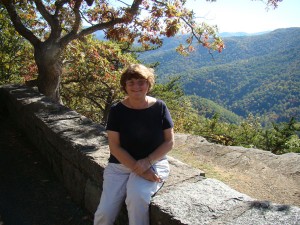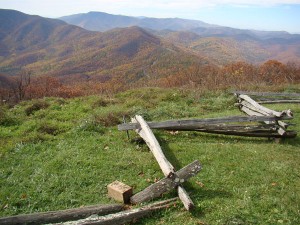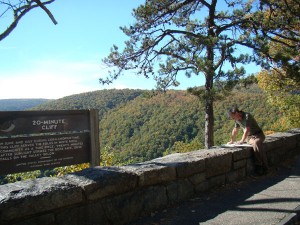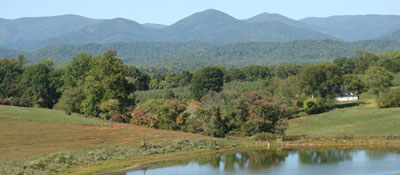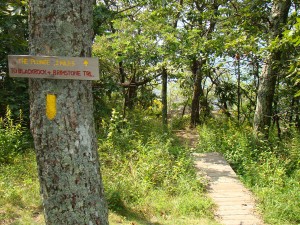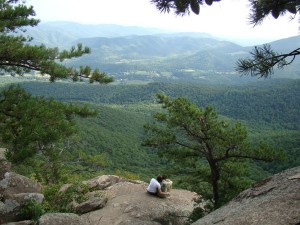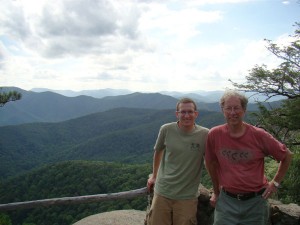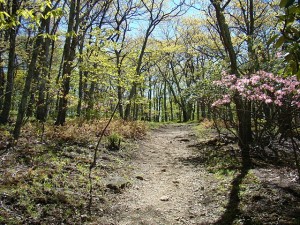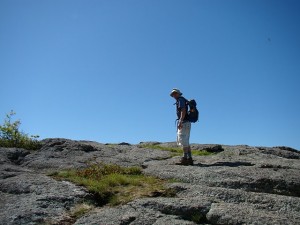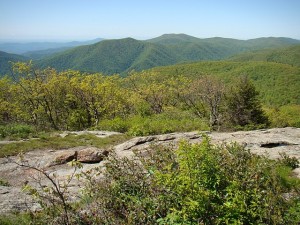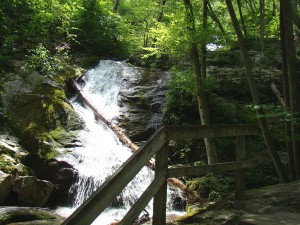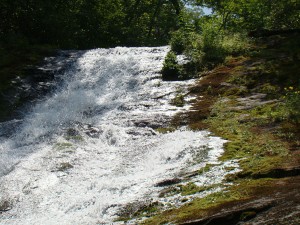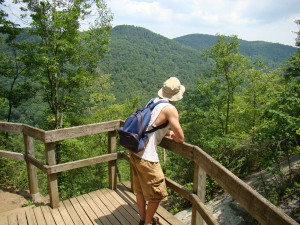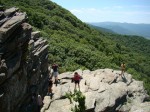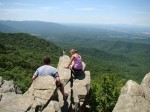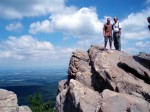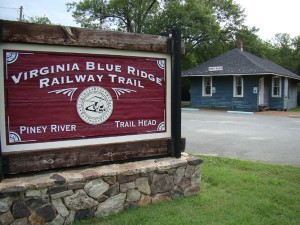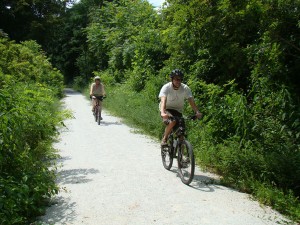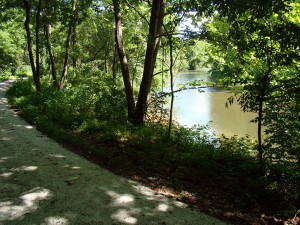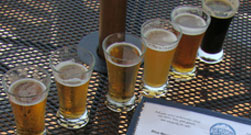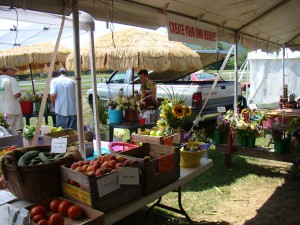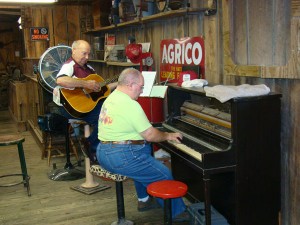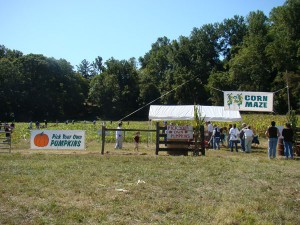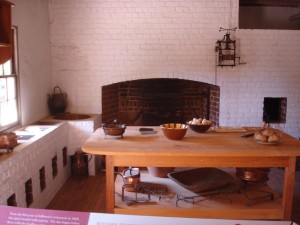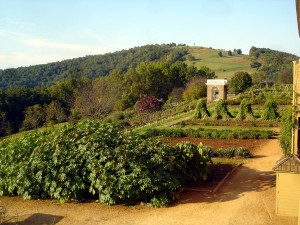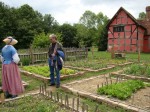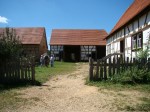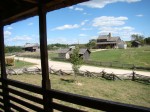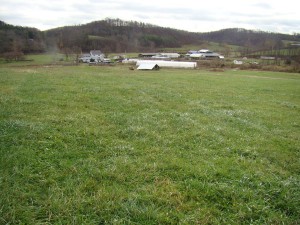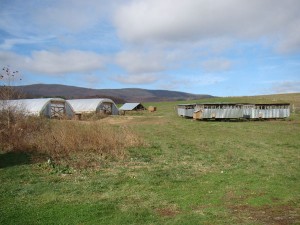This page is aimed at our potential visitors who are new to Nelson County and the area. Our Local Picks are not in any way meant to be an exhaustive list of things one can do locally, but rather represent some of the things we like most and have found guests up to now to enjoy as well. The idea is that you can be thinking ahead about how you may want to spend your time during your visit down here.
Walks from Our Doorstep
There are pretty nice views from inside our home, but a little walking produces a variety of new vistas and offers the potential of spotting wildlife, farm animals, and abundant wildflowers, along with insights into local history. And they’re available 24/7, without a car.
Our own homegrown trail system: It’s not quite the AT (Appalachian Trail), but I’ve developed four interconnected trails within our five acre property which circle the gorgeous mountain laurel blooms in season, meander through our woods, and offer views of local farms and mountains. They’re there to wander at any time, and if you’re lucky, you may spot one of the large pileated woodpeckers that inhabit these woods.
Our local cemetery: A short walk up our dirt road and across Route 151 brings you to the Jonesboro Cemetery, which offers both extraordinary views of the mountains in all directions and also insights into local history. All the early Nelson county families are represented here, and the gravestones offer silent but moving testimony to some of the tragic moments in this county’s history, most notably the death and devastation wrought by Hurricane Camille in August 1969. It’s a beautiful, sometimes sad, but intriguing place.
A Stroll to a Suspension Bridge: Not exactly from our doorstep, but only about ten minutes away, is a brief walk to a suspension bridge on the Appalachian Trail where it crosses the Tye River. The bridge is quite neat (kids of all ages love making it bounce and swing) and affords beautiful views up and down the river. Herons and egrets are sometimes seen here. The low point on the AT between the peaks of Three Ridges Mountain and The Priest, this section of the trail involves the largest amount of elevation change in ten miles on the entire AT.
Touring by Car
Many of the major roads in the county offer great views, but two stand out as particularly spectacular:
Blue Ridge Parkway: The Blue Ridge Parkway extends from the southern end of Skyline Drive, which goes through Shenandoah National Park, to the Great Smoky Mountains, 469 miles in all. Built and landscaped in part by the Civilian Conservation Corps and the Works Progress Administration during the 1930s, it is one of this region’s true treasures. In Nelson County, it runs along a ridge in back of the mountains we see from our property, and can be reached in about twenty minutes. We mainly frequent the 27 miles between Rockfish Gap (at Route 64) and Route 56, which is just two miles down the road. There are many wonderful lookouts and short trails, as well as excellent signs and exhibits, including the Humpback Farm Museum at the Humpback Rocks Visitor Center.
Dark Hollow Road: Less than ten minutes away, this country road winds along a mountain ridge to the east of us. It provides the most spectacular panoramic views of the Blue Ridge mountains to the west that we know of, with orchards, cattle pastures and ponds in the foreground. In spring one can pick strawberries, and apples in summer, at Seaman’s along the road. The serene agricultural setting feels like another world.
Hiking
There are dozens of hikes to choose from in our immediate area. My favorites so far are:
The Plunge: This hike up at the Wintergreen Resort is really short (.2 miles each way), but is rocky and steep. The views both to the mountains and down into the Rockfish Valley are truly spectacular. The hike can be extended by looping back on either the Blackrock or Brimstone Trail.
Spy Rock: Spy Rock is a rocky dome that provides one of the best views (360 degrees) of the central Blue Ridge mountains. The trailhead (at the Montebello fish hatchery, an interesting place in its own right) is only about 20 minutes away, and the round-trip hike only 3.2 miles. In the spring, the forest on the way up is filled with flaming azaleas.
Crabtree Falls: Since Crabtree Falls is actually a series of falls, this hike can vary from a few minutes to several hours, depending on how high up one goes. Fenced platforms serve to keep people off the slippery rocks and to provide good viewpoints. A nice shady hike for a hot day, although the falls are at their fullest in the spring.
Humpback Rocks: This jagged rocky overlook provides stunning views of the Shenandoah Valley and the mountains in Shenandoah National Park just to the north. The trail, accessed from the Blue Ridge Parkway, is a fairly steep one mile each way, and a bit of rock scrambling is necessary at the top. Standing on top gives one quite a sense of accomplishment! Across the parkway at the bottom is an excellent visitor center and mountain farm museum.
The Priest and Three Ridges Mountains in winter
In addition, the Appalachian Trail crosses Nelson County, sometimes interweaved with the Blue Ridge Parkway. 544 miles of the 2175 mile-long AT, which runs from Georgia to Maine, are in Virginia, accounting for one-quarter of the total. Roughly 45 miles of the AT go through Nelson County, including the major summits in the region, The Priest and Three Ridges Mountain. In late spring and early summer 2011 I hiked this section of the AT; you can click on the “Appalachian Trail” category at the top of the right toolbar for pictures and further details.
Biking
Off-road biking trails are few in number in this region, but the Virginia Blue Ridge Railway Trail along the Piney River, five miles south of us, offers a pleasant “rails to trials” ride of fourteen miles roundtrip, with lovely views of both the river and agricultural landscapes.
Wintergreen Resort
Wintergreen Resort, built in the aftermath of Hurricane Camille as part of a reconstruction and development plan for the region, has proven to be a fairly good environmental citizen, even if its (mostly part-time) residents tend to live in a world apart. Billed as a four-season resort, Wintergreen offers skiing and golfing and other sports. The Wintergreen Nature Foundation maintains an extensive network of trails and runs informative guided nature walks most Saturday and Sunday mornings. The resort contributes to the tax base of the county and has encouraged a more developed commercial infrastructure than is typically found in other rural Virginia counties.
Sampling Local Brews and Wines
There are ten wineries, one cidery, and three breweries in Nelson County, most of them offering tasting in beautiful settings. The county website provides details and links to individual winery and cidery websites. All three breweries have indoor/outdoor eating and drinking areas, two with excellent mountain views. Delfosse Winery, pictured above on the left, also hosts a five-mile hiking trail. Most local breweries and wineries host special events, such as concerts and festivals, in addition to wine tasting on their premises.
Farmers’ Markets and Farm Stores
Farmers’ markets in summer and fall are both colorful and great places to sample local, mostly organically-grown, produce. Several larger farms have their own farm stores and may host annual festivals as well. A number of orchards offer U-Pick days and direct on-farm sales. Above: the Nellysford Farmer’s Market, old-time music at Saunders Brothers, and the fall harvest festival at Flippin Seaman.

Farther Afield (but within an hour’s drive)
Monticello: Thomas Jefferson’s home and slave plantation, with all the complexities of historical interpretation that comes with that. A handsome new visitor center offers a short film orientation and other exhibits. Tickets include a tour of the main house and optional tours of the gardens and Mulberry Row, where most slaves lived. Worth exploring on one’s own is the subterranean labyrinth below the house where skilled house slaves prepared the sophisticated food for Jefferson’s sumptuous dinners and carried out the myriad of chores required to support the plantation lifestyle (Monika and I were the lucky recipients of a tour by historian and horticulturalist Leni Sorensen, whose insights we’re happy to pass on as best we can).
Frontier Culture Museum: Over the mountains in the Shenandoah Valley near Staunton is this wonderful outdoor “living” museum which showcases three reconstructed working farms from European areas of emigration to this area (Germany, England, Ireland) and one from eastern Nigeria where many enslaved people came, along with two from more recent periods of Virginia history. A beautiful, educational, and fascinating place.
UVA and Charlottesville: Founded by Jefferson in 1819 and opening in 1825, the University of Virginia’s central campus still reflects Jefferson’s basic plan. Charlottesville sprawls in all directions and offers what one can expect in a mid-sized university town in the way of bookstores, restaurants, etc. And most importantly, it’s home to Nic and Alison!
Lynchburg Antique Row and Community Market. The late Jerry Fallwell notwithstanding, Lynchburg is a surprisingly interesting place. Located on the James River that loops around later to form the southern border of Nelson County, the (doubly-ambivalent) legacy of the fabulous wealth gained from the slave plantation tobacco trade is still richly evident. For those with interest in antiques in the broad meaning of older stuff, Antique Row offers many treasures in the old industrial buildings along the river. Right across the street is a nice community farmers market as well.
Closer to home, there are a variety of smaller interesting country stores around that can be considered museums where you can handle (and purchase, if you wish) the historical artifacts of everyday life, e.g. the Covesville Country Store, the Rockfish Gap Country Store, and several interesting antique malls.
Polyface Farm. Not exactly a standard tourist destination, but a kind of pilgrimage site for many readers of Michael Pollan’s The Omnivore’s Dilemma, which introduced Joel Salatin and his uniquely sustainable farming practices to the general public. Polyface Farm is about an hour’s beautiful drive over the Blue Ridge mountains and then across the Shenandoah Valley. A farm store is open weekday mornings and on Saturdays; visitors are welcome to explore the farm on their own. If you’re familiar with CAFO’s (confined animal feeding operations), you cannot fail to be struck by the good life Polyface Farm animals live, even if they are eventually destined for human consumption.
